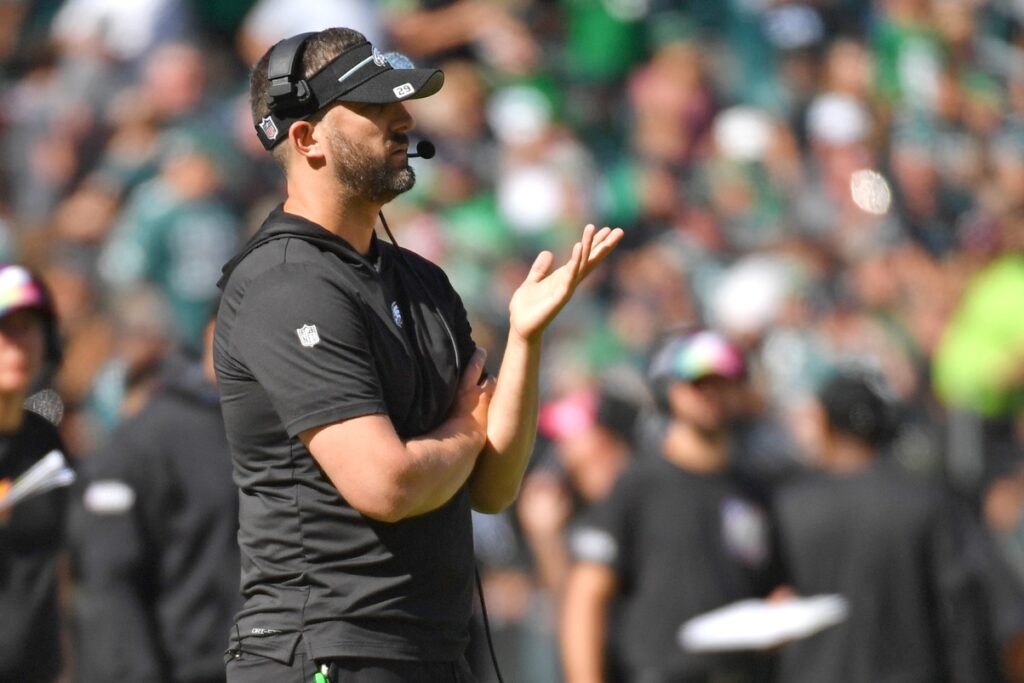Ad Disclosure
Nick Sirianni Explains Two Situational Decisions from Sunday’s Win

Weird couple of days for Nick Sirianni. His team is 4-0 and scored 31 points in regulation on Sunday before kicking a game-winning 54-yard field goal. We’d all be happy with that in a vacuum, and should be happy regardless of the circumstances. But Tuesday morning he admitted to inserting himself into Red Zone decision making and used his day-after press conference to explain a couple of situational play calls from the win:
Q. If I can follow up on a game situation – 9:41 to go in the fourth quarter, Washington had the illegal formation on a third down. You accepted the penalty to push them back. What factored into that decision? (Zach Berman)
NICK SIRIANNI: Good question on the stop on third down. What happened was on that, it’s third-and-1. We stuff them on a quarterback sneak. And the information I got from the officials is that it would be a fourth and half a yard or it would be a third-and-6. I know what we’re doing on fourth and half a yard (the push) and I know that we’re really good at that play. But the percentages of guys converting on a fourth-and-1 is high, over 70 percent. So that’s definitely in my mindset. It’s tough.
Do we expect to be good at short yardage offense? Yes. Do we expect to be good at short yardage defense? Yes. But I’m also playing a little bit of the odds there as far as ‘what’s the down and distance here?’ So, it’s going to be fourth down. How many yards to go? They said half a yard. I said, ‘okay, I’ll take them back then.’
They converted on the third down, so I understand that that’s my job that I’m going to have to face some criticism there that I didn’t take it into fourth down. I understand that.
I did the same thing in New England. We had a stop on third down. It was fourth down and I had an opportunity to either take them back and knock them out of field goal range or take the penalty and risk the third-down conversion, or decline it and they would have been in field goal range. That one we took them back. We had a great stop.
Sometimes that’s going to work and sometimes it’s not. In those situations, I have just to be convicted in what I’m doing. And my conviction there was, ‘hey, let’s see if we can stop them on third-and-6 and then see what happens on fourth down.’ I just thought they were going to go for it on fourth and half a yard there.
That’s fine. For added context, Washington was on the Eagles’ 26 yard line to begin, down 24-17 at that point. Accepting the penalty moved them back to the 31, and if they hadn’t converted the ensuing third down play, they would have likely been kicking a 48-yarder to cut the lead to four with about nine minutes remaining.
Here’s the other situation:
Q.Right before the half after WR DeVonta Smith’s catch, why didn’t you call time out there?(Jeff McLane)
NICK SIRIANNI: So, you’re looking at if you call a timeout, then you’ve got the ball with 38 seconds, no timeouts — 37 seconds with no timeouts at, I believe, the 26. Or you don’t take the timeout and you get a play run. And we ended up snapping the ball at 20 seconds. They obviously reviewed it and you go from there.
It’s just a matter of if you want a timeout or not in those particular cases. When you have the timeout, we try to hold that timeout as long as we possibly can. Everything’s a factor. Everything’s in play.
We have a very specific chart of when we’re calling timeouts on certain amount of gains, on short yardage, and also when we’re clocking it in those scenarios. I followed our chart and what it said there in that particular case.
If I had to do it over again, I’d do the same thing because that’s not a time to have knee-jerk reactions. You have to make these decisions very quickly. That’s why we study everything that we do in every scenario, even to a point of every detail of how you call a timeout or clock a ball is thought of in very detail.
That doesn’t mean it doesn’t change ever. You’re going to see some plays throughout the year. Every week on Thursday, I watch every clock play. Every clock play. And not only for the NFL but also the Power 5 conferences, which happen a little bit different, but at least you can put yourself in that scenario over and over and over and over again.
Wouldn’t mind looking at that chart. For educational purposes, of course, not to give it to opposing teams.
Kevin has been writing about Philadelphia sports since 2009. He spent seven years in the CBS 3 sports department and started with the Union during the team's 2010 inaugural season. He went to the academic powerhouses of Boyertown High School and West Virginia University. email - k.kinkead@sportradar.com